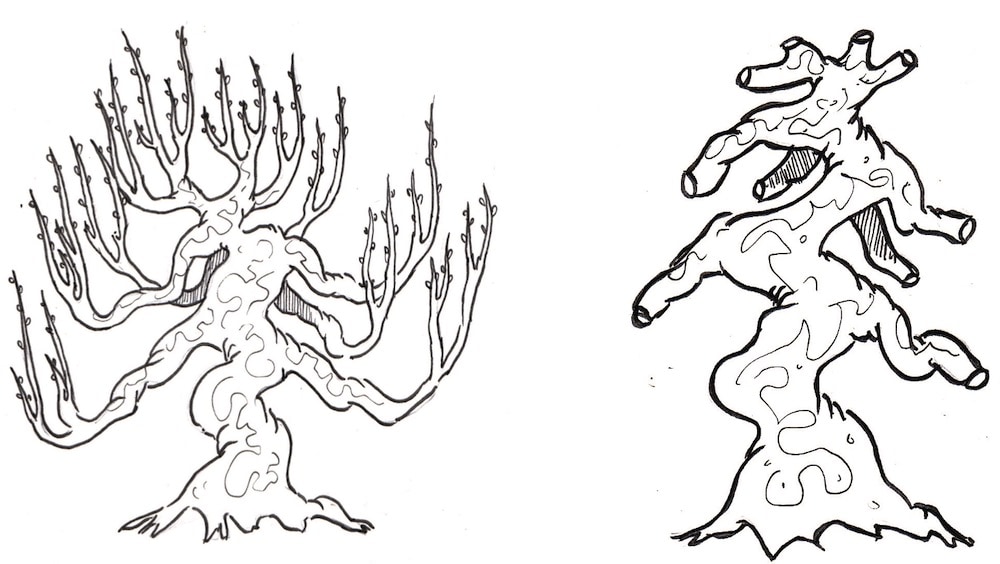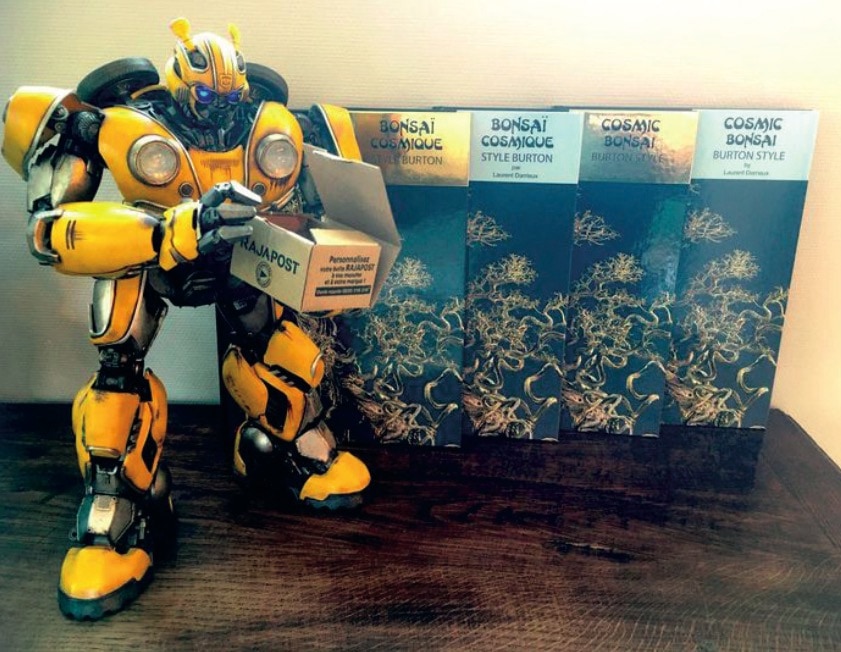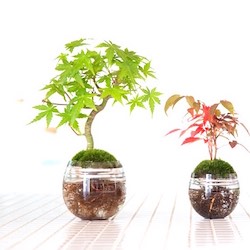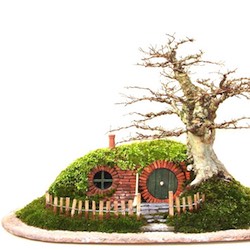In this blogpost about the Kozumikku style, Laurent Darrieux talks about what led him to create an atypical style, and how it’s done.
Laurent Darrieux started Bonsai in 1987 with his father, and this passion would never leave him. Parts of this post come from his books named Cosmic Bonsaï. Let's find out more about the Kozumikku or Burton style of Bonsai!

The Kozumikku style
We will focus here on what differentiates the Kozumikku style from all of the other Japanese styles of bonsai, such as Moyogi, Netsuranari, Shokan, Chakkan, Ishitsukki, etc. We will also seek to explain the historical reasons which led us to seek an alternative way rather than following the existing styles offered by the Japanese or the Chinese which are culturally related to their history as well as to their respective traditions.
The Kozumikku style is not opposed to tradition, it is a legitimate evolution due to it’s emancipation from existing codes and from a static position of certainty. Kozumikku deliberately departs from the pretence of other styles as it does not set out to recreate a tree growing in a natural state, on the contrary by dominating the plant and overruling it’s natural biological habits, the forms cannot exist in the natural world.

This convoluted method of shaping, allows us to bypass the natural laws governed by apical force and phototropism – those forces which are governed by solar attraction and natural laws. Emphasis is placed upon the inclusion and repetition of fractal forms typical of trees growing on our star and which will be set aside for the time it takes to form the tree and where it will reside thereafter. It’s important to note that with exception to some of the techniques employed in creating this form which allow it to be uniquely obtained, generally the techniques used to achieve this style are classical methods used within typical bonsai development. What distinguishes the Burton Style from others to date, is that it is the only style which neither seeks to replicate nature and does not occur independently within the natural world.
“It is the only style which neither seeks to replicate nature, nor occurs independently within the natural world”
Cosmic Bonsai, or Kozumikku
The cosmic style starts from the premise that it is possible to create new forms of bonsai using modern techniques that are parallel and not in opposition to commonly accepted rules and knowledge. It borrows a large majority of means in producing traditional Bonsai with the distinction that it frees itself from the existing boundaries and framework.


In order to achieve this, it draws upon the reimagination from films, comics, 3D images or any other artistic mediums that have taken advantage of the imagination: The flying rocks of the film Avatar, the giant Cinderella bramble and many, many others. It also allows further modification in breaking from tradition by forging new forms of containers with high feet, tentacles, bolts and other types of forms. Progression in this way provides new possibilities allowing a more evolved interaction between tree and vessel limited only by the human imagination. The list of possibilities offered by the Kozumikku style is non-exhaustive and the door we have opened in recent years allows us to foresee that future generations will go even further than we have so far today. Once applied within our potted trees, it would inevitably become necessary to consider the possibilities when our principles are applied within the manner and means in which bonsai are presented and displayed. Once we are able to imagine these modern trees departing from their traditional iconography and associations it’s possible to conceive allowing ourselves to develop new forms of display such as replacing traditional wooden shelves with new ones, constructed with modern materials such as metal, glass or cement with the only condition being that they are beautifully made or at least very carefully considered and that they demonstrate a particular finesse of work.


As for the traditional accompanying figurines, it becomes possible to replace them with robots, monsters, or any other modern toy. It is then only logical to reconsider the cultural context and coherence in terms of using the Kakemono (hanging scroll) and which will also require utilising your imagination in order to enable the enable the whole composition cohesion. Rather than being bound by traditions the messages delivered by these new forms of presentation could provide alternative means of expression, offering a new artistic medium for artists wanting to comment – painters, photographers and sculptors have done so via their mediums for centuries, so why not bonsai artists? A platform for political communication or for delivering a message of peace or why not criticism of a fundamentally capitalist world which denies the beauty of life, and demonstrates every day a little further our inability as a human race to live in harmony with it.
How it’s done
The major rule of this style, which opposes the traditional rules of bonsai, is that you should never cut the tips of your branches or the top of your trunk before the general shape of the tree is reached. Once you’ve gained the general mature structure that you intended, only then may you cut the tips at the desired places in order to move on to secondary branching; then tertiary in order to prepare your tree for a possible exhibition. If you apply this simple rule and increase the size of your pot each year without cutting the roots and just filling the gaps with new substrate you will have quality tree structures in just three or four years. It will obviously not be a fully finished tree, but it will start to provide you with some degree of satisfaction when you realize the progression from what you started with.

Let your trees go, work with them and let them grow again, you will discover that the end result is not the end to be achieved because, as a friend who has passed away often told me. “It’s not the goal you reach that’s most important, it’s the path you take to get there. Because the goal when we finally reach it is always disappointing.”
If my eyes could still see it, my mind disagrees with portraying the falsehood of a humanity in harmony with nature and not perceiving it as anything other than merely consumable raw material for profit, consumption and exploitation. Either it is I who is blind to the reality of the events that surround me, or it is the others. Personally, I think I’m pretty far-sighted.
Techniques for obtaining the Kozumikku style
Starting from the most common Japanese style, Moyogi, though it works with all styles from Kengai to Neagari. On the sketch here you can see the basic structure used to get this shape.
The major difference between the Kozumikku style and the original Moyogi style is that in the first case we use the lengths of branches to create evolutionary material, while in the second we cut the branches at the level of the carpenters to develop secondary and then tertiary branching.

On this diagram we can see the clean cuts as they are practiced in the world of classic Bonsai and which will allow the craftsman once the new shoots in place, to structure trays and a top around the trunk.
If we return to the first diagram we can see that we do not cut anything from the initial structures, they will serve us on the contrary to be ligated in order to give the tree new lines of branches. The major fight of the Kozumikku style is to eradicate gourmands systematically starting from the base of the ligated branches (red line). The tree always tries to grow via the shortest and most efficient way towards the sun and to avoid obstructions. You are free to tie up the gourmands well located according to your creativity or to eliminate them if you feel that they do not meet your expectations.

In this sketch we have deliberately cut the tree in half so that you are able to understand the importance of leaving the growing tree free or under ligature constraints depending on where you want to lead it. It is sometimes interesting to let certain parts of the tree grow for a few months to enlarge certain parts of the trunk and branches of our choice. Keep in mind that there will always be time for you to rewire particular parts of the tree according to the plan that you have in mind, obviously within proportion to the plants power and the growth of the tree you’re working on.
Applied scarification tools and techniques
In these photos we can clearly see old healed openings that we are going to reopen within the existing scars. For finer work (photo on the left) we use a robust and pointed tool to drive it into the bark and allow the lifting of it. For coarser work and removing material, a rounded blade is used (photo on the right).
Results obtained after removing the cambium and sapwood to the heartwood. This practice can be performed up to 4 times depending on the essence of the tree and the vigour of the latter.



The philosophy of the Kuzomikku style
The Kuzomikku style offers the infinite possibility of new forms of bonsai with an intrinsic message declaring an unlimited, unconditional love of trees and the unequivocal freedom of expression necessary today for their preservation, continued existence and perhaps their very survival. Entirely rethinking our way of doing things and reshaping our ways of thinking will allow us to change the very course of bonsai as an art form and practice this art in a more rational way and relevant manner in relation to the period in which we live. The postulate of this art form is therefore absolutely not to go against nature, but to learn how to shape it in symbiosis with human beings in order to better understand it.

If we accept the notion that bonsai is an artistic form shaped and constrained by human hands and therefore artificial, we can then see the possibility of working our trees in different ways which might be more in communion with those trees which accompany our lives.
When we take our first steps upon the bonsai path we convince ourselves that it is us whom command and shape the plant on which we place our hands every day and that it depends on our good care. As we grow, mature and pay closer attention, we come to understand that it is the plant that shapes us and that it is we who depend upon it.
In this new concept and way of understanding Bonsai you will see that because we’re working on a small scale, it’s possible for us to create all the possible movements by the ligature with the only condition being, that the end of the branch emerges the crown, allowing it to continue photosynthesis and grow normally. The only constraint of this technique is obviously to leave the aluminium wire in place long enough around the branch, so that its structure can hold in place once the wire’s removed. We accept that the branch marks the cambium beneath the wire for one or two seasons, safe in the knowledge that these marks will quickly disappear with proper cultivation and monitoring of your tree. It should be noted that it is sometimes possible to speed up the healing process of wounds by practicing scarification around the wire scars, imparting the formation of repetitive wedges which, if they’re regularly reopened, will eventually overlap one-another, creating a beautiful material effect. Much like trees which are regularly injured in the wild and which defend themselves by recreating beads of natural sap in order to protect themselves.

Once we’re able to comprehend that the only limit of the plant is that which we humans impose on it, we may start to progress toward the realisation that the plant has absolutely no limits. If a tree grown in a pot receives all the care it needs and is in good health, it only remains to provide it with sufficient recovery time following whatever technical method that come to mind is applied. Ultimately it is a mere question of plant knowledge and personal feeling.
Nature without limits
Nature doesn’t concern itself with the rules dictated by humans because it grows – its sole ambition is to survive, develop and reproduce. At no time does she aspire, dream or even conceive of being conditioned by man within a cramped pot, and forced to depend upon him for water or her food needs. To accept the very concept of making Bonsai is to embrace the idea that we control and condition a life form within a receptacle, that we will do everything in our power to afford it everything it requires, whilst manipulating and coercing it to procure a personalised aesthetic form. Refusing to accept this state of affairs is to deny the very essence of Bonsai and concede in fact, not to understand it at all. The very soul of the practice of Bonsai is to capture nature mastered by man. Personally I affirm and maintain that any essential notion of nature is totally foreign to the world of Bonsai. Respect for nature in this case is gained by virtue of playing with it. The only way we could really and truly respect it would be to leave it free and wild, merely contemplating it. As typical humans we are incapable of relinquishing control – this is what separates us from the very notion of nature. Consider this exerpt from the excellent book written by Paul Lesniewiscz (The World of Bonsai: 1982). It has been forty years since it was published and yet it remains so profound:
"The more man's self-knowledge has developed in recent centuries, the more he has behaved as a master and ruler of nature. The absolute monarchs of the Baroque age only tolerated it as a geometric spectacle that one discovered from the terrace of the castle and which should be lost in infinity, a carpet of filigree shrubs, a sea of flowers with volutes unending. The lords of the small duchies did not like having before their eyes a nature of which one could recognize all the limits.”

Bonsai is an entirely artificial activity, since it’s born of the fruit of human manipulation in all of its manifestations. This led me empirically and without really being entirely conscious of it at the time, to the creation of the Kozumikku style. I found that the existing dogma of people who had perpetuated the rules failed to master the depth of the historical spiritual experience. These people had developed a very general and approximate knowledge and appeared to want me to believe and accept that growing a tree in an artificial pot; to wrap aluminium wire around the branches at a certain angle, whilst utilising ancestral codes (of which they appreciated very little) were all «natural» processes required to construct a representation of nature. To this day (with the exception of a minority of a few trees that I have seen in Master Murata’s garden in Japan, which are developed by pruning alone), it seems to me that the hundreds of thousands of Bonsai that I have seen in my life in Asia or in the West withheld nothing at all «natural», but had much more in common with a geometrically organized view of human-centred nature.

We thank Laurent Darrieux for his willingness to share insight into the Kozumikku technique and Cosmic Bonsai. Visit his website for more information and here you can buy his books as well. Let's end with a fitting quote; [...] our human race is only a trivial incident in the history of creation: humanity is perhaps an error, an abnormal growth, a disease of the system of Nature. I never participate in what surrounds me, I am nowhere in my place. - by H.P. Lovecraft.




